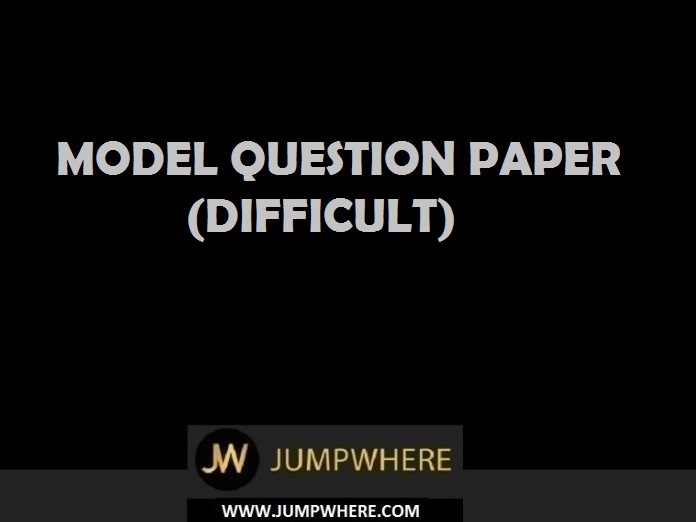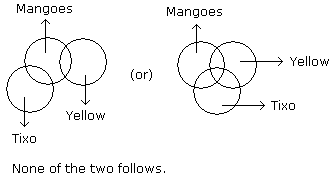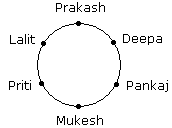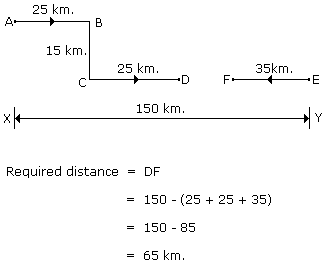Instructions for Aptitude Model Question Paper (Difficult – Level) test:
- You can select only one option at a time.
- The order of the question and the options will change randomly every time you take the QUIZ.
- You can take the QUIZ multiple times.
- Each question will carry 1 points.
- There are altogether 50 questions.
- After finishing the test, you will get score message as shown below.

- If you score more than 90% or more you will get a unique code and Whatsapp Number along with the score message.
- Take the screenshot of the entire page containing the message along with the unique code generated.
- Lucky winners will get exciting goodies/gift from JUMPWHERE. The final decision will be taken by JUMPWHERE TEAM itself.
- This contest is available only till 4-11-2022 11:59 PM.
- Don’t forget to Like and Follow us on Instagram and facebook for all the updates.
Aptitude Model Question Paper (Difficult – Level)
Model Paper - Difficult
Question 1 |
A | 16:15 |
B | 4:5 |
C | 1:2 |
D | 3:5 |
Question 2 |
A | 51 |
B | 50 |
C | 49 |
D | 52 |
So, missing term = 28 + (52 - 1) = 28 + 24 = 52.
Question 3 |
Arrange the following in a logical order :
- Shoulder 2. Wrist 3. Elbow 4. Palm 5. Finger
A | 2, 4, 5, 3, 1 |
B | 3, 4, 5, 2, 1 |
C | 3, 1, 4, 2, 5 |
D | 5, 4, 2, 3, 1 |
(i) from top to bottom, i.e, Shoulder, Elbow, Wrist, Palm, Finger - Which is 1, 3, 2, 4, 5 (or)
(ii) from bottom to top, i.e, Finger, Palm, Wrist, Elbow, Shoulder - Which is 5, 4, 2, 3, 1
Out of these, the sequence 5, 4, 2, 3, 1 is given in the alternatives provided. Hence, the answer is (D).
Question 4 |
A | 4 / 216 |
B | 1 / 216 |
C | 3 / 216 |
D | 1 / 36 |
simultaneously is:
= 6×6×6×6 = 6 4
n(S) = 6 4
Let X be the event that all dice show the same face
X={(1,1,1,1,),(2,2,2,2),(3,3,3,3),(4,4,4,4),(5,5,5,5),(6,6,6,6)}
n(X) = 6
Hence required probability,
= n(X) / n(S)
= 6 / 6 4 = n(X) / n(S) = 6 / 64 = 1 / 216
Question 5 |
S1. The first thing that strikes you as your Airbus lands at Don Muang Airport is the heat and the humidity.
A. Japanese tour groups, complete with Nike shoes and matching bags; huge contingents from mainland China easily distinguishable with their obsession with Khaki, animated Malaysians, colourful smatterings of Indonesians and Koreans and the rest. B. In Thailand, it is hot and humid, very hot and humid or mild and humid. C. Many a thousand of tourists descending upon a kingdom which must boast the most successful tourism industry in the world. D. Almost as overwhelming is the rush of humanity as you approach the immigration clearance area.
S6. The inclement weather apart. Thailand is overstuffed with cars, choked with auto pollution, and always in a state of flux.
A | CADB |
B | CDAB |
C | BDCA |
D | CBAD |
Question 6 |
A | Buccal |
B | Bureaucracy |
C | Brettle |
D | Boycott |
Question 7 |
A | 30 |
B | 50 |
C | 25 |
D | 20 |
Question 8 |
A | 8:3 |
B | 2:1 |
C | Cannot be determined |
D | 3:2 |
8 hrs 48 mins
= 8 + (48/60)
= 8.8
x/(b - s) = 8.8
x/(b + s) = 4
8.8(b - s) = 4(b + s)
2.2b – 2.2s = b + s
1.2b = 3.2s
b:s = 8:3
Question 9 |
A | Calmly he warned her that be quite or else he will have to shoot her. |
B | He warned her calmly that he would shoot her if she didn't keep quite. |
C |
He said calmly that I shall shoot you if you don't be quite.
|
D | He warned her to shoot if she didn't keep quite calmly. |
Question 10 |
Statements: Some mangoes are yellow. Some tixo are mangoes.
Conclusions:
I) Some mangoes are green.
II) Tixo is a yellow.
A | Neither (1) nor (2) follows |
B | Only (1) conclusion follows |
C | Either (1) or (2) follows |
D | Only (2) conclusion follows |
Question 11 |
Arguments:
I. No. This is not advisable as the jobs should be offered to only deserving candidates without any reservation for a particular group.
II. Yes. This will help reduce the growing population in India as the parents will be encouraged to adopt single child norm.
A | Only argument II is strong |
B | Either I or II is strong |
C | Both I and II are strong |
D | Neither I nor II is strong |
E | Only argument I is strong |
So, abolishing the practice of reservation altogether has no meaning. Thus, argument I is vague. Also, more reservations would lead to non-recruitment of many more deserving candidates.
Besides, such a reservation, if implemented, will cater to the job requirements of only a small section of population and not a major part of it.
So, argument II also does not hold strong.
Question 12 |
A | 46 |
B | 221 |
C | 25 |
D | 109 |
445
(445-3)/2 = 221
(221-3)/2 = 109
(109-3)/2 = 53
(53-3)/2 = 25
(25-3)/2 = 11
(11-3)/2 = 4
Clearly, 53 should have come in place of 46
Question 13 |
A | caused a pleasant atmosphere |
B | brought about disharmony |
C | brought about a disciplined atmosphere
|
D | caused unnecessary worries |
Question 14 |
A | I |
B | L + M + O |
C | K |
D | K + J + I |
Question 15 |
I) On the day the Barton triplets are born,
II) Jenna weighs more than Jason.
III) Jason weighs less than Jasmine.
IV) Of the three babies, Jasmine weighs the most.
If the first two statements are true, the third statement is
A | Uncertain |
B | True |
C | False |
Question 16 |
Grease the palm?
A | to help
|
B | to break trust |
C | to bribe |
D | to break promise
|
Question 17 |
A | 15 |
B | 10 |
C | 18 |
D | 20 |
(t+10) = (2/3) * (f+10)
3T + 30 = 2F + 20
2F - 3T = 10
2*(2T) - 3T = 10
T = 10
F = 2T = 20
Question 18 |
A | Candid |
B | Direct |
C | Forthright |
D | Genuine |
Question 19 |
A | Praise |
B | Remedy |
C | Love |
D | Resentment |
Question 20 |
Statements: Quality has a price tag. India is allocating lots of funds to education.
Conclusions:
I. Quality of education in India would improve soon.
II. Funding alone can enhance quality of education.
A | Either I or II follows |
B | Neither I nor II follows |
C | Both I and II follow |
D | Only conclusion I follows |
E | Only conclusion I follows |
This means that quality of education will improve in India.
So, I follows. But funding alone is sufficient to enhance quality, is not true.
So, II does not follow.
Question 21 |
A | 300 m |
B | 200 m |
C | 350 m |
D | 250 m |
Let the altitude of triangle is h1 and of parallelogram is h2 (which is equal to 100m), then
Area of triangle = (1/2)*b*h1
Area of rectangle = b*h2
As per question (1/2)*b*h1 = b*h2
(1/2)*b*h1 = b*100
h1 = 100*2 = 200m
Question 22 |
- examine 2. I have 3. brought 4. over you to 5. some books
A | 23154 |
B | 23541 |
C | 23514 |
D | 54123 |
E | 25431 |
Question 23 |
Who are the neighbours of Mukesh according to the given scenario?
Six friends are sitting in a circle and are facing the centre of the circle. Deepa is between Prakash and Pankaj. Priti is between Mukesh and Lalit. Prakash and Mukesh are opposite to each other.
A | Prakash and Deepa |
B | Lalit and Priti |
C | Priti and Pankaj |
D | Deepa and Priti |
Question 24 |
Unlike Ancient Greek art which saw the veneration of the animal form and the development of equivalent skills to show musculature, poise, beauty and anatomically correct proportions, Ancient Roman art depicted gods as idealized humans, shown with characteristic distinguishing features.
A | While Ancient Greek art venerated the animal form and developed equivalent skills to show musculature |
B | Ancient Greek art saw the veneration of the animal form and the development of equivalent skills to show musculature |
C | While Ancient Greek art saw the veneration of the animal form and developed equivalent skills to show musculature |
D | Unlike Ancient Greek art which saw the veneration of the animal form and the development of equivalent skills to show musculature |
E | Unlike Ancient Greek art which venerated the animal form and the development of equivalent skills to show musculature |
B. The sentence is cumbersome because of the repetitive use of the comma. Also lacks parallel construction.
C. While.... takes care of the difference highlighted in the sentence. The original sentence talks of both veneration…and development…as predicates of the verb saw; here developed is constructed in parallel with saw – thus changing the intent of the sentence.
D. Correct. Use of while is required. Venerated..... and developed.... are parallely constructed and conform to depicted…
E. Use of unlike..... is incorrect. Greek Art did not venerate the development of.....
Question 25 |
A | 1, 2 |
B | 4, 1 |
C | 2, 3 |
D | 3, 2 |
--------
5 | y -1
--------
| 1 -4
y = (5 x 1 + 4) = 9
x = (4 x y + 1) = (4 x 9 + 1) = 37
Now, 37 when divided successively by 5 and 4, we get
5 | 37
---------
4 | 7 - 2
---------
| 1 - 3
Respective remainders are 2 and 3
Question 26 |
A | 3:4 |
B | 1 : 1 |
C | 4 : 3 |
D | 2 : 3 |
5/100 A + 4/100 B = 2/3(6/100 A + 8/100B)
1/20A + 1/25B = 1/25A + 4/75B
(1/20-1/25)A = (4/75-1/25)B
1/100A = 1/75B
A/B = 100/75 = 4/3
Required ratio = 4:3
Question 27 |
Statement: The Committee has criticized the Institute for its failure to implement a dozen of regular programmes despite an increase in the staff strength and not drawing up a firm action plan for studies and research.
Courses of Action:
I) The broad objectives of the Institute should be redefined to implement a practical action plan.
II) The Institute should give a report on reasons for not having implemented the planned programmes.
A | Neither I nor II follows |
B | follows |
C | Both I and II follow |
D | Only I follows |
E | Either I or II |
So, either there should be reasons for the lackening or the plans are a failure and must be revised for practical implementation.
Thus, both the courses follow.
Question 28 |
A | 0.95 |
B | 1.06 |
C | 0.97 |
D | 0.86 |
=> [(a3 - b3) / (a2 + ab + b2)] = (a - b)
=> (0.96 – 0.1) = 0.86
Question 29 |
Two cars start from the opposite places of a main road, 150 km apart. First car runs for 25 km and takes a right turn and then runs 15 km. It then turns left and then runs for another 25 km and then takes the direction back to reach the main road. In the mean time, due to minor break down the other car has run only 35 km along the main road. What would be the distance between two cars at this point?
A | 80 km |
B | 65 km |
C | 75 km |
D | 85 km
|
Question 30 |
A | 27 |
B | 28 |
C | 35 |
D | 25 |
So, in case of correct distribution, P would have got,
=> 117 × 66 + 4 + 3 = Rs. 54
Q would have got, = 117 × 46 + 4 + 3 = Rs. 36
and R would have got, = 117 × 36 + 4 + 3 = Rs. 27
But actually the money was divided in the ratio 2 : 3 : 4 and shares of P, Q and R in this case would be
For P, = 117 × 22 + 3 + 4 = Rs. 26
For Q, = 117 × 32 + 3 + 4 = Rs. 39,
and for R, = 117 × 42 + 3 + 4 = Rs. 52
Thus P gains, = 54 − 26 = 28,
Q gains, = 36 − 39 = −3 (loss)
and R gains, = 27 − 52 = −25 (loss)
Thus, P gains the most Rs. 28
Question 31 |
A, B and C start a business investing a total amount of Rs.7,50,000 . B left the business after 16 months and C left 4 months after B. After 2 years, the total price earned is Rs. 3,80,000. If A invested Rs.50,000 more than B and B invested Rs.50,000 more than C, find A’s share of the profit?
A | Rs. 1,80,000 |
B | Rs.1,90,000 |
C | Rs. 85000 |
D | Rs. 1,70,000 |
B=C+50000
A+B+C = 750000
B+50000+B+B-50000 = 750000
B = 250000
A=300000
C=200000
Ratio of profit share = (30*24) : (25*16) : (20*20)
= 720:400:400
= 9:5:5
A’s share = (9/19)*380000
= Rs. 1,80,000
Question 32 |
A | snake : egg |
B | predator: den |
C | meadow : grass |
D | parasite : host |
Question 33 |
A | 3% Loss |
B | 3% Profit
|
C | 2% Loss |
D | 2% Profit |
So, C.P. = (100110 ∗ 25.75)When S.P. = 25.75 then
Profit=25.75 − 25 = Re.0.75
Profit%=0.7525 ∗ 100=3%
S.P. = (100 + gain%100 ∗ C.P)So,
C.P. = (100110 ∗ 25.75)When S.P. = 25.75 then Profit = 25.75 − 25=Re.0.75
Profit%=0.7525 ∗ 100 = 3%
Question 34 |
A | 13/16 |
B | 63/80 |
C | 31/40 |
D | 7/8 |
Since,70/80>65/80>63/80>62/80>, so 7/8,>13/16>63/80>31/40
So, 7/8 is the largest.
Question 35 |
A | 18 |
B | 81 |
C | 27 |
D | 36 |
Thus, 1*2 = 2,
2*3/2 = 3,
3*2 = 6,
6 * 3/2 = 9 and so on
Missing number = 18 * 3/2 = 27
Question 36 |
A | 22 metric tonnes |
B | 26 metric tonnes |
C | 24 metric tonnes |
D | 28 metric tonnes |
Question 37 |
A | 48 km/hr |
B | 10 km/hr |
C | 36 km/hr |
D | 19 km/hr
|
And, they are moving in the opposite direction, they take 25 seconds to cross each other
Let the required speed of the trains be X m/sec
Now, from the formula (a + b)/(u + v), we have a = b = 250 m and u = v = X m/sec
Then, a + b = 250 + 250 = 500 m and u + v = 2X m/sec, 25 = 500/2X sec
X = 10 m/sec = 10 x 18/5 km/hr = 36 km/hr
Hence, the speed of two trains is 36 km/hr
Question 38 |
A | 8% |
B | 6.5% |
C | 6% |
D | 7% |
Then, 1200 x (1 + R / 100)2 = 1348.32
(1 + R/100)2 = 134832 / 120000 = 11236 / 10000
(1+ R / 100)2 = (106 / 100)2
1 + (R /100) =106 / 100 R = 6%
Question 39 |
Statement:
Use X brand shoes. These are durable and available in all sizes. An advertisement in the newspaper A.
Assumptions
I) Normally people like durable shoes.
II) Very few people read advertisement in a newspaper.
III) Very few people read the newspaper A.
A | Only I and II are implicit |
B | Only I and either II or III are implicit |
C | None of these |
D | None is implicit
|
E | Only II implicit |
So, I is implicit. The 'X' brand has advertised its product in newspaper A.
This implies that a large section of people reads advertisements in newspapers and that newspaper A too has a wide circulation.
So, neither If nor III is implicit.
Question 40 |
A | 6 |
B | 5 |
C | 8 |
D | 7 |
= 2 + 3 = 5 rounds per hour
=> They cross each other 5 times in 1 hour and 2 times in 1/2 hour
Time duration from 8 am to 9.30 am = 1.5 hour
Hence they cross each other 7 times before 9.30 am
Question 41 |
A | tenant
|
B | dwelling |
C | house |
D | kitchen |
You do not need a tenant (choice a) in the domicile, nor do you need a kitchen (choice c).
A house (choice d) is just one form of a domicile (which could also be a tent, Hogan, van, camper, motor home, apartment, dormitory, etc.).
Question 42 |
A | 480 liters |
B | 300 litres |
C | 240 liters |
D | 360 liters |
Part of the tank emptied by the outlet in a minute = 1 / (5*60) = 1/300
Part of the tank filled in the first 30 minutes = 30*[(1/x) - (1/300)]
= (300 - x) / 10x Part of the tank filled in the next 36minutes = 36 * (1/x)
1 – [(300 - x) / 10 x] = 36 / x
Solving, x= 60
Capacity of tank = 60 * 5 = 300 liters
Question 43 |
A | Saturday |
B | Friday |
C | Thursday |
D | Sunday |
Today is Sunday (27th dec)
New year falls on Friday
The difference between Christmas and new year is 7 days (0 odd days)
Hence, they fall on the same day
Question 44 |
A | MCNOQN |
B | MNCNOQ |
C | CMQNNO |
D | MCNQON |
Question 45 |
If A $ B means A is the brother of B; A @ B means A is the wife of B; A # B means A is the daughter of B and A * B means A is the father of B, which of the following indicates that U is the father-in-law of P?
A | P @ Q $ W * T # U |
B | P @ Q $ T # U * W |
C | P @ W $ Q * T # U |
D | P @ Q $ T # W * U
|
Q $ T → Q is the brother of T ...(2)
T # U → T is the daughter of U
Hence, → Q is the son of U ...(3)
U * W → U is the father of W
From (1) and (3), U is the father-in-law of P
Question 46 |
Statements:
I) Many people in the area are reported to be suffering from Malaria
II) Private Medical Practitioners in the area have decided to close their clinics for few days
A | Both the statements I and II are effects of independent causes |
B | Both the statements I and II are effects of some common cause |
C | Statement I is the cause and statement II is its effect |
D | Statement II is the cause and statement I is its effect |
E | Both the statements I and II are independent causes |
Because spreading malaria or to be suffering from malaria may be due to mosquitoes or dirtiness
But the decision of private medical practitioners to close the clinics may be due to other causes
Question 47 |
Read the each sentence to find out whether there is any grammatical error in it. The error, if any will be in one part of the sentence. The letter of that part is the answer. If there is no error, the answer is 'E'. (Ignore the errors of punctuation, if any).
A | No error. |
B | since eight o'clock. |
C | I was standing |
D | waiting for him |
E | at the bus stop
|
Question 48 |
A | 1:6 |
B | 4:3 |
C | 2:3 |
D | 6:1 |
S.P. of 1 litre of mixture = Re.1, Gain = 50/3 %
C.P. of 1 litre of mixture = (100 x 3/350 x 1) = 6/7
By the rule of allegation, we have:
C.P. of 1 litre of water C.P. of 1 litre of milk
0
1
7
Mean Price
Re. 6/7
Re. 1
6/7
Ratio of water and milk = 1:6 = 1:6.
Question 49 |
A | 678954 |
B | 876524 |
C | 103680 |
D | 465765 |
These three objects can be arranged in 3!=63!=6 ways.
Let us fix one of these 6 arrangements.
This may give us a specific order, say, novels -> fairy tales -> plays.
Given this order, the books on the same subject can be arranged as follows.
The 4 books on fairy tales can be arranged among themselves in 4!=244!=24 ways.
The 5 novels can be arranged in 5!=1205!=120 ways.
The 3 plays can be arranged in 3!=63!=6 ways.
For a given order, the books can be arranged in 24×120×6=1728024×120×6=17280 ways.
Therefore, for all the 6 possible orders the books can be arranged in 6×17280=6×17280= 103680 ways.
Question 50 |
| walk | skip | run |
| toss | pitch | ? |
A | hurl |
B | dance |
C | jump |
D | swerve |
[vc_btn title=”More Aptitude Question” color=”warning” size=”lg” align=”center” link=”url:https%3A%2F%2Fjumpwhere.com%2Faptitude%2F||” button_block=”true”]






